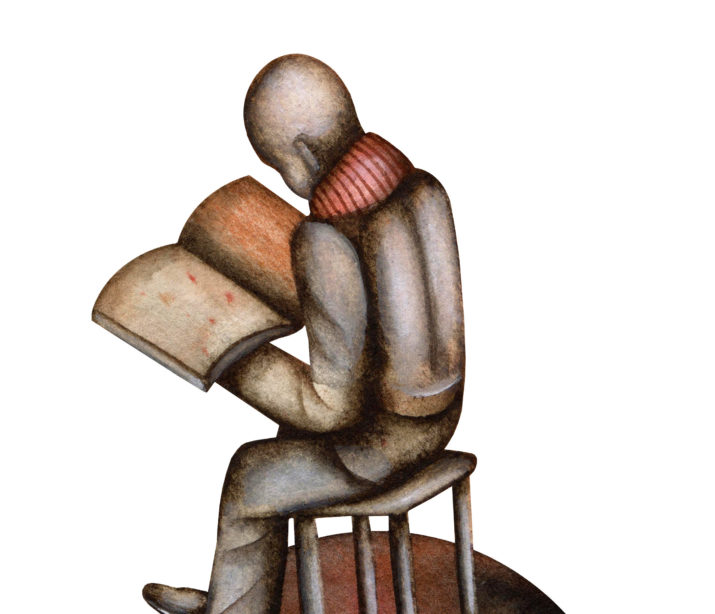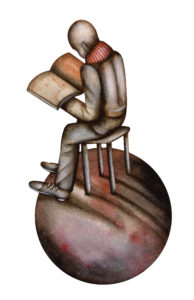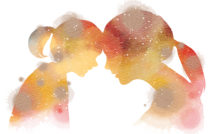

This is part of our special feature on Crime and Punishment.
Leaving the prison at 9:00 P.M. after teaching for almost three hours, tonight I am wrung out, happy-exhausted really, because there has been so much energy pin-balling around the classroom. And I feel guilty, as usual, because I can leave and my students cannot. Razor wire glitters in the dark as I walk down the hill from the school building to the front gate. Not for the first time in my experience, I see a bus idling in the dark as women board, holding small bundles of their possessions. I know what this means: They have been drafted, transferred to another correctional facility. A good thing in one way: A transfer is a step down from this maximum-security prison to a medium-security one, hence closer to release; but, unfortunately, it may also mean a much greater distance from loved ones. And perhaps one of my students, who was absent tonight, is on that bus, being sent, usually with little or no notice, to a place where she may not be able to continue her college education. I cannot see faces in the dimly lit interior of the bus.
I began teaching college, under the auspices of Mercy College, in the New York State Correctional system in the 1980’s at a minimum-security women’s facility in Manhattan. The college program, like the facility itself, was a bare-bones kind of operation: no office for professors, no library for the students, few supplies. But I loved the work right from the beginning: I loved the great range of ages in the classroom, and the fact that we were all women together. The small size of the classes (capped at twenty students, per prison regulations) was also a luxury given other adjunct courses I had taught previously. And to my surprise and relief, no correctional officer sat in the classroom, or even listened at the door.
I taught psychology, sociology, and anthropology courses at that prison until the mid-1990’s, when Clinton’s Crime Bill abolished Pell grants for felons, thereby ending the handful of prison college programs around the country. In 1997-98, I began teaching at a newly restarted college program in a maximum-security New York State prison, where I have now been for twenty years.
I cannot believe, to this day, that I have been fortunate enough to be able to do what I do. I deeply thank the inmates who banded together to plead for, and work towards, restoring college, the administration who listened to them, and so many members of the community, educators, and deans on the “outside” who made it all happen. I am still, even now, working on incorporating a number of insights, emotions, and profound changes I personally have experienced in doing this work. I do not have it all put together because the experience keeps growing.
For example, I tell myself and anyone who is interested that these are students like other students. First and foremost, I do not think of them as inmates, and I plan course content in no way different from the content of courses I taught for several decades as an adjunct instructor at a satellite University of Connecticut (UConn) campus. I have never expressed an interest in their crimes, nor have I sought information online (easy to do). And I tired long ago of strangers and acquaintances being curious about any “famous criminals” in my classes. A fairly predictable list of questions people ask includes: “Are you scared?” “Aren’t the women really tough?” “Don’t the women resent you because you are free?” “Don’t they just sit around all day and watch TV anyway?” The answer to all of these is no. Perhaps the most common question is, “What are they in for?” The women will ever be labeled in society’s mind-eye by their crimes.
At the same time, it is not strictly true that these prison students are like any others: They are, overall, more motivated, more demanding, more grade-conscious, more curious than students I had at UConn. Being smart, knowing things, is valued here. Not always the case in mainstream youth culture. Another significant difference: Most prison students come to college already questioning the world as it is. I believe that this comes naturally to many of them, because they grew up at the short end of privilege. I see it as my job to give them the theory and data necessary to back up their views when it comes to the elusiveness for many of the American dream, the perniciousness of racism, and the disturbing currents running in politics today. In contrast, at UConn I spent a fair amount of time illustrating to students that not everyone can make it in America, and that racism is not a “thing of the past,” (which was the mantra of many of the white students).
In any case, the prison students have, in their turn, strongly disputed my “just like students on the outside” stance. They argue, “we are different: We are in prison.” But that’s just context – or is it? The students challenge me to dig deeper.
Indeed, one cannot escape the totalizing effect of being in prison. Even for the few hours a week I am there, a corner of my mind remains alert. I feel a kind of subliminal anxiety: that I will inadvertently offend the system, and be booted out; fear that I will make a mistake that will be taken out on a student or students. I have to be careful, for my own sake, but more so for the sake of the students and the college program. I have to make sure to take the nail file out of my bag, and the gum (can be used to gum up locks!), and any maps even if of the Kalahari Desert (may be used to plan an escape!); I have to hang for dear life onto my prison ID, should it go missing there may well be a massive cell search or lock down. This heightened awareness, and scrupulous politeness and patience with bureaucracy, I consider a worthwhile state of mind to cultivate, a survival skill for modern life in general. In prison, it is an absolute necessity if one is to take care of oneself and get one’s work done.
But, of course, the important point is that if I feel a kind of underlying anxiety, what are the women themselves feeling? There are certainly times in class when they let out their pain, frustration, fear, and anger. We – the students and I – try to put the emotions to intellectual use.
It’s a difficult translation, that, from emotion to intellect. We talk about C. Wright Mills’ famous dictum, the sociological imagination, which asks us to connect our personal problems to larger social issues and forces. Those, our society tends to push to aside, preferring to heap all responsibility upon individuals. Sometimes, students embrace that linkage of personal problems and social issues on the spot; other times, it may take much longer. Of course, for us all, it is a life-long task.
What are the tough things pedagogically about teaching in a prison? One challenge is to find ways to connect the women to the world outside. There is no access to the internet; guest speakers require a great deal of planning ahead and approvals/clearances, which can take weeks. Newspaper subscriptions are very expensive and timely deliver is uncertain (must be inspected). Yes, there are TVs on the housing units but the majority of inmates are not in college, and it is the majority that controls the selection of programs. As a result, news or other educational fare gets short shrift.
So, at times, I become a storyteller, describing the Great Mosque in Damascus where the remains of John the Baptist are worshipped, the leaf huts built and owned by BaMbuti women in the Congolese rain forests (simply dismantled when a woman wants a “divorce”), and the favelas of Brazil, where women do not mourn their babies’ deaths, instead seeing the deaths as births of angels. At times, this all feels like a spirit journey, or the exercise of a kind of global and transhistorical imagination.
Many of my students have never been to a museum, never driven on a highway, never been on a plane, and of course most of them are woefully behind the times when it comes to our fast-moving new technologies. Still, they often amaze me with the amount of knowledge they have been able to grasp when it comes to modern life outside the prison. And part of the reason for this is the sheer amount of talking that goes on, the power of a verbal grapevine, and a genuine passion to not be left behind. Once, teaching a new course on material culture and its impact on human behavior and belief systems, I recognized initial skepticism. Some of the students who were new to me came into the classroom the first night, with stony faces and “show me” body language. At the end of the lecture, we began discussion, and one of the new students testily said, “I have a question. Is this course being taught anywhere else?” And I understood that what she was asking was, “Taking this course, are we in the mainstream?” She did not want a course that had been cooked up just for prison college; she did not want to be left out of the so-called real world. And the great news on this front is that our program has, for several years now, been able to teach “inside/out” classes, with college students from the outside coming in to take classes with our students. This has been a tremendous opportunity for both populations to learn from each other on the one hand, but also to share aspects of the common student experience.
Another challenge is addressing the powerful and healing role of religion in the lives of many of the students. When I am presenting information that is contrary to their religious beliefs, I must state up front that I am aware of the problem I may be dumping on some of them. Fierce and fascinating discussions come up with some regularity, especially when I teach the course, Evolution for Social Scientists. Here are some of the questions from students, to peers as much as to me:
“Is the problem that we insist on a literal interpretation of a sacred text?” (This one can start a shouting match)
“Is religion in the Bible, or is it in us?”
“Who wrote the Bible?”
“Can religion be misused?”
“Can you be a good person without being religious?”
“Dr. G., are you religious?”
“Are most biologists religious?”
On one occasion, a student offered the class the following, from a previous anthropology course she had taken with me: “Those Pygmy people we studied last year, they didn’t have a book, they couldn’t even read, but they had religion, and they were peaceful and good and happy.” This did not satisfy everyone in the class, you can be sure. But I was pleased.
Another new, and sensitive, course I taught in the fall of 2002 concerned the cultural and psychological effects of human-designed spaces. In developing the course, I had been mindful of the trickiness of the subject: We would be talking about confining spaces, gendered spaces, forbidden spaces, gates and fences and all manner of barriers. I did not want a top-heavy focus on the prison experience of space, but it hovered over so many discussions: of personal bodily space, of spaces which exist as “safe,” sequestered repositories for impurity or otherness. The prison is one such place, a powerful symbol of the attempt to eject “impurity,” from the (imagined) “purity” at the center of society. Yet we noted the odd way in which the prison, so aggressively fenced and razor-wired, and fitted with heavy metal doors, nonetheless reveals a fear of permeability. A subliminal recognition of the impossibility of perfect separation, perfect containment. The prevention of inmate escape is, of course, the manifest function of all of this security. But it bleeds over into the more nuanced function of keeping people out. There is a kind of dual fear of contagion, inside to outside, outside to inside. Civilians may come in with progressive ideas, love, contraband items, all of which undermine the power of the institution to maintain a punitive ethos. Contagion in the other direction in that civilians could take out what was supposed to kept walled off, specifically the knowledge of the humanity of inmates. Is that what I am trying to do here? Yes.
In any case, in the course we did cover more than the prison experience of human-made spaces. We talked about the traditional Chinese family compound, the Enclosure laws in England at the beginning of the Industrial Revolution, the derivation of the word “ghetto,”, the gentrification of Harlem, and the use of fountains and waterfalls in malls to naturalize the shopping experience. And religion came up again: One of the students lighted up upon reading that in the Mongolian ger or yurt, the sacred books are kept on the men’s side of the tent. She excitedly addressed the class: “Think about it, all of you…the women couldn’t go there. Nowthink about the Garden of Eden, that’s a male space, God’s space, Adam’s space in the beginning…Remember? And Eve was punished for seeking knowledge…she ate the fruit of the tree of knowledge.”
That example epitomizes the rewards of this teaching, which far offset pedagogical challenges or the difficulties inherent in the prison context. Other rewards include that we professors get to know our students in deeper ways than would be possible in a large college or university (the small size of the program, and the fact that the students cannot take a full course load per semester as a result of prison work schedules means that it takes quite a while to earn a bachelor’s degree). We can truly mentor students and track their progress. (Another advantage for instructors is that we are able to teach a variety of courses, even on occasion designing our own.) And I have to mention the highlight of the school year: graduation. To see students walk up onstage to receive their diplomas, usually accompanied by their children or parents, is pure joy. The cheers are deafening, and the tears flowing.
Several years ago, I asked a group of my students what they wanted to say to the outside world. Here are some of their answers:
“I am part of the whole – my function came from the whole because this is society and I am a product of that society.”
“I am part of your hate, of your love, of your law, and of your ideas about poverty.”
“I don’t have to be the person who you make me out to be, I don’t have to conform to that stigmatization.”
“Tell the world we work all day, we work hard in here, and then to come to college at night, that’s hard. But we make that choice, it matters.”
“Tell those on the outside that we are a real community.”
And here, in a conversation mode outside of class, is an exchange on the social construction of reality, between a serious young student and a keen-minded older student:
Younger: “I never thought of things in terms of systems, structures…it’s depressing, in a way, to see all the hidden things I never knew about.”
Older: “But it makes you stronger. No one ever said knowledge is without pain.”
Julia Goggin Gardiner earned her Ph.D in 1987 from the Graduate Faculty of The New School for Social Research, studying critical anthropology under the late Stanley Diamond. She has worked as a youth counselor, Affirmative Action counselor in the corporate world, director of a youth center for at-risk teenagers in New York City, and as adjunct instructor at Mercy College, William Paterson College, Eastern Connecticut State University, the University of Connecticut, and currently for Marymount Manhattan College.
Published on November 8, 2018.
Photo: Man sitting on the Moon and reading a book, Eugene Ivanov | Shutterstock




